Economics Report: Regression Analysis of Graduation & Retention
VerifiedAdded on 2023/04/21
|10
|1926
|343
Report
AI Summary
This report investigates the relationship between graduation and retention rates in 29 online colleges in the United States using linear regression analysis. The study aims to determine the impact of retention rate on graduation rate. Descriptive statistics reveal average retention and graduation rates of 57.41% and 41.76%, respectively, with higher variability in retention rates. A scatter plot suggests a positive association between the two variables, which is further supported by a regression equation: Graduation rate = 25.42 + (0.29 * Retention rate). The slope coefficient indicates that for every unit increase in retention rate, the graduation rate increases by 0.29 units. The regression model shows a statistically significant positive association. The R-squared value of 0.45 suggests a moderate fit, with retention rate explaining 45% of the variation in graduation rate. Specific cases like South University and University of Phoenix are discussed, highlighting areas for improvement. The report recommends that universities focus on strategies to increase retention rates to enhance graduation rates, such as innovative teaching techniques and improved transparency.
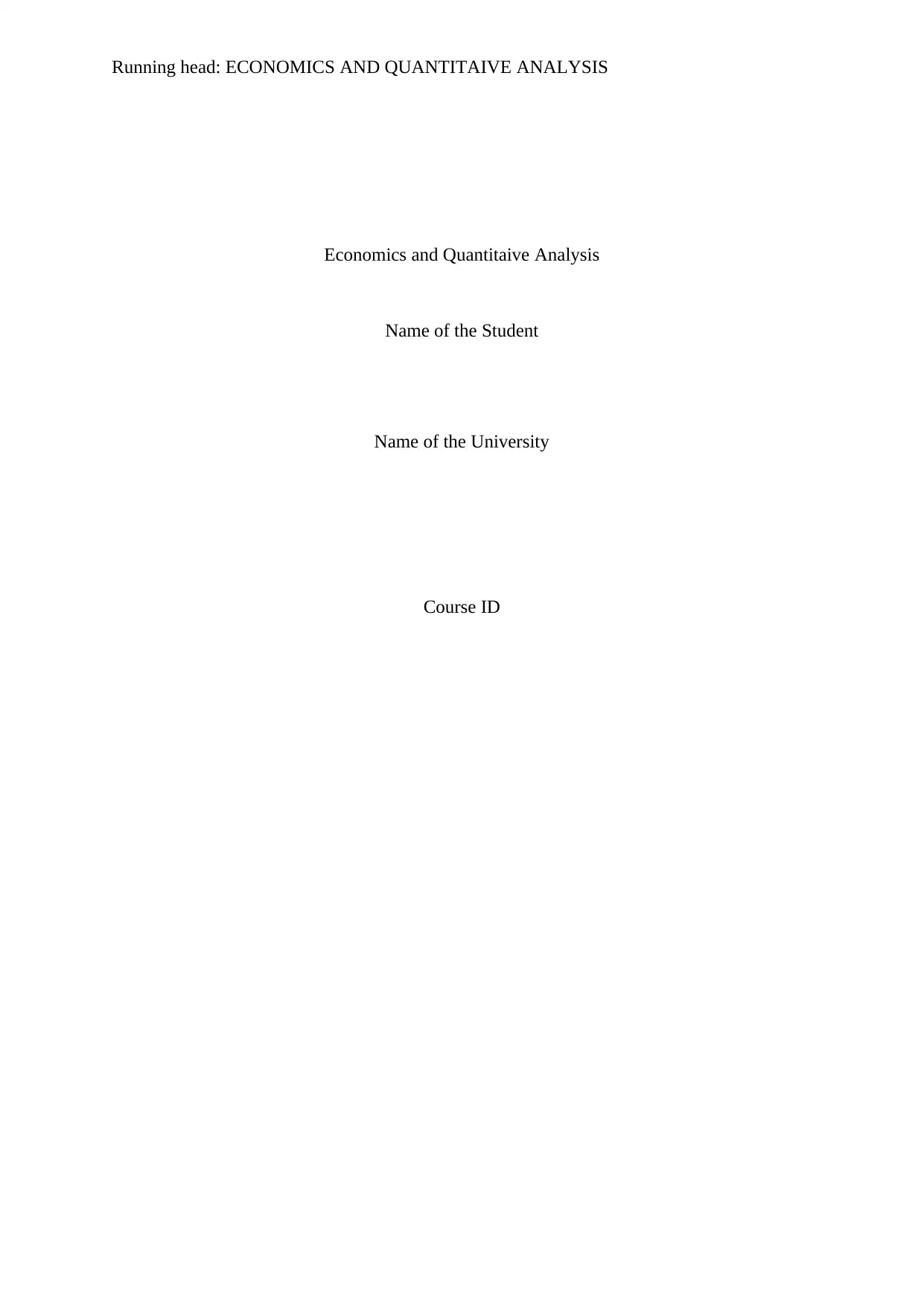
Running head: ECONOMICS AND QUANTITAIVE ANALYSIS
Economics and Quantitaive Analysis
Name of the Student
Name of the University
Course ID
Economics and Quantitaive Analysis
Name of the Student
Name of the University
Course ID
Paraphrase This Document
Need a fresh take? Get an instant paraphrase of this document with our AI Paraphraser
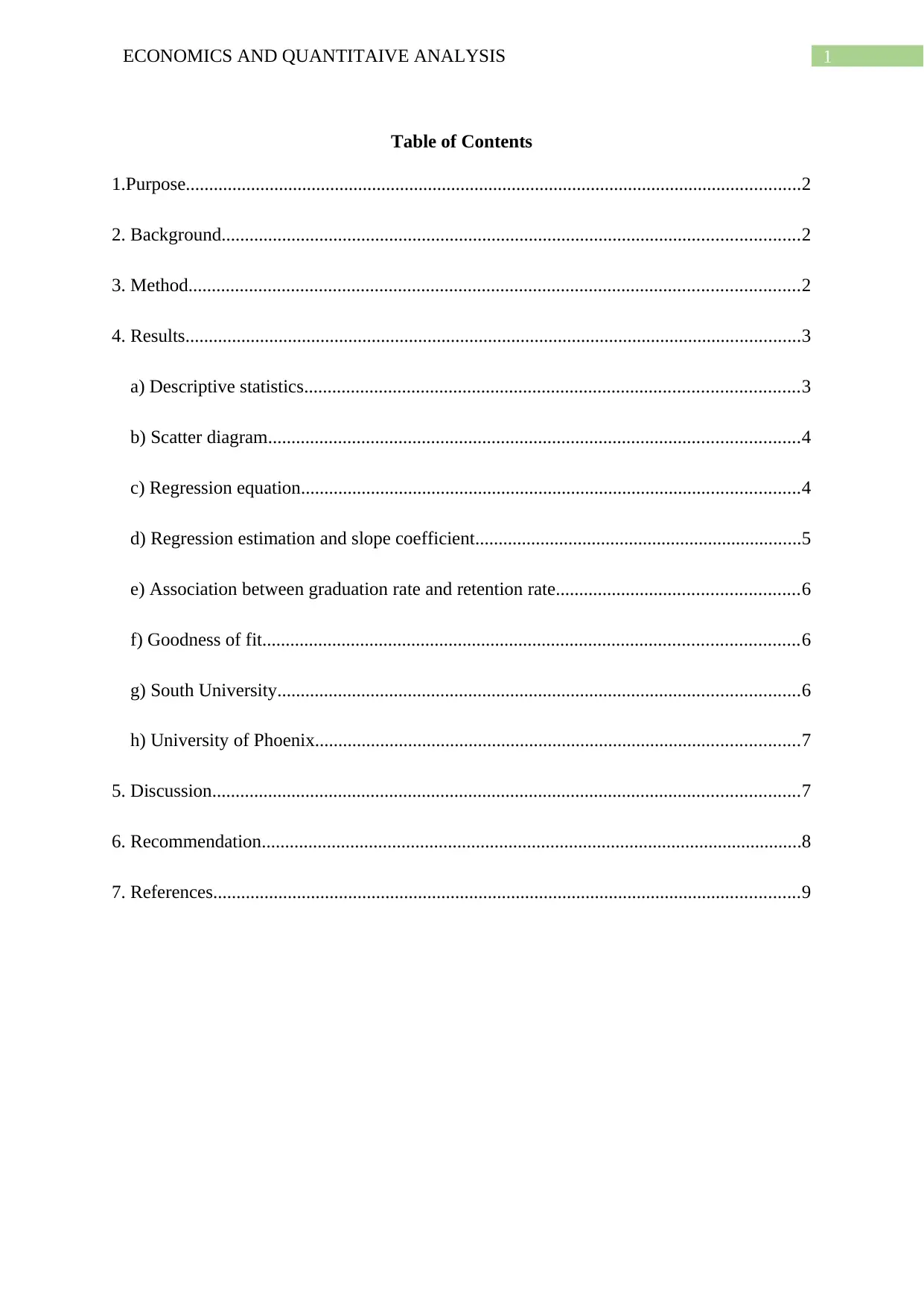
1ECONOMICS AND QUANTITAIVE ANALYSIS
Table of Contents
1.Purpose....................................................................................................................................2
2. Background............................................................................................................................2
3. Method...................................................................................................................................2
4. Results....................................................................................................................................3
a) Descriptive statistics..........................................................................................................3
b) Scatter diagram..................................................................................................................4
c) Regression equation...........................................................................................................4
d) Regression estimation and slope coefficient......................................................................5
e) Association between graduation rate and retention rate....................................................6
f) Goodness of fit...................................................................................................................6
g) South University................................................................................................................6
h) University of Phoenix........................................................................................................7
5. Discussion..............................................................................................................................7
6. Recommendation....................................................................................................................8
7. References..............................................................................................................................9
Table of Contents
1.Purpose....................................................................................................................................2
2. Background............................................................................................................................2
3. Method...................................................................................................................................2
4. Results....................................................................................................................................3
a) Descriptive statistics..........................................................................................................3
b) Scatter diagram..................................................................................................................4
c) Regression equation...........................................................................................................4
d) Regression estimation and slope coefficient......................................................................5
e) Association between graduation rate and retention rate....................................................6
f) Goodness of fit...................................................................................................................6
g) South University................................................................................................................6
h) University of Phoenix........................................................................................................7
5. Discussion..............................................................................................................................7
6. Recommendation....................................................................................................................8
7. References..............................................................................................................................9
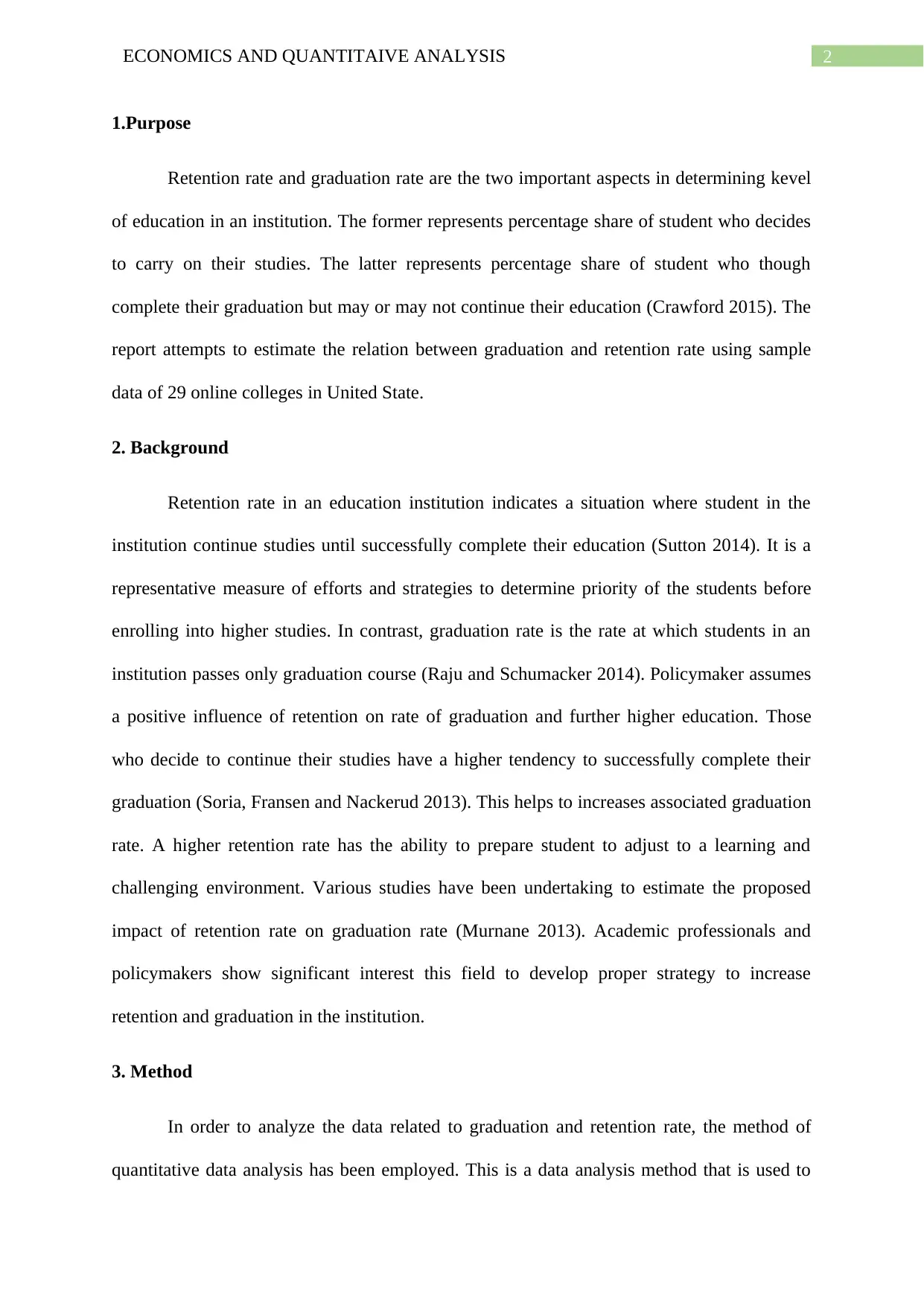
2ECONOMICS AND QUANTITAIVE ANALYSIS
1.Purpose
Retention rate and graduation rate are the two important aspects in determining kevel
of education in an institution. The former represents percentage share of student who decides
to carry on their studies. The latter represents percentage share of student who though
complete their graduation but may or may not continue their education (Crawford 2015). The
report attempts to estimate the relation between graduation and retention rate using sample
data of 29 online colleges in United State.
2. Background
Retention rate in an education institution indicates a situation where student in the
institution continue studies until successfully complete their education (Sutton 2014). It is a
representative measure of efforts and strategies to determine priority of the students before
enrolling into higher studies. In contrast, graduation rate is the rate at which students in an
institution passes only graduation course (Raju and Schumacker 2014). Policymaker assumes
a positive influence of retention on rate of graduation and further higher education. Those
who decide to continue their studies have a higher tendency to successfully complete their
graduation (Soria, Fransen and Nackerud 2013). This helps to increases associated graduation
rate. A higher retention rate has the ability to prepare student to adjust to a learning and
challenging environment. Various studies have been undertaking to estimate the proposed
impact of retention rate on graduation rate (Murnane 2013). Academic professionals and
policymakers show significant interest this field to develop proper strategy to increase
retention and graduation in the institution.
3. Method
In order to analyze the data related to graduation and retention rate, the method of
quantitative data analysis has been employed. This is a data analysis method that is used to
1.Purpose
Retention rate and graduation rate are the two important aspects in determining kevel
of education in an institution. The former represents percentage share of student who decides
to carry on their studies. The latter represents percentage share of student who though
complete their graduation but may or may not continue their education (Crawford 2015). The
report attempts to estimate the relation between graduation and retention rate using sample
data of 29 online colleges in United State.
2. Background
Retention rate in an education institution indicates a situation where student in the
institution continue studies until successfully complete their education (Sutton 2014). It is a
representative measure of efforts and strategies to determine priority of the students before
enrolling into higher studies. In contrast, graduation rate is the rate at which students in an
institution passes only graduation course (Raju and Schumacker 2014). Policymaker assumes
a positive influence of retention on rate of graduation and further higher education. Those
who decide to continue their studies have a higher tendency to successfully complete their
graduation (Soria, Fransen and Nackerud 2013). This helps to increases associated graduation
rate. A higher retention rate has the ability to prepare student to adjust to a learning and
challenging environment. Various studies have been undertaking to estimate the proposed
impact of retention rate on graduation rate (Murnane 2013). Academic professionals and
policymakers show significant interest this field to develop proper strategy to increase
retention and graduation in the institution.
3. Method
In order to analyze the data related to graduation and retention rate, the method of
quantitative data analysis has been employed. This is a data analysis method that is used to
⊘ This is a preview!⊘
Do you want full access?
Subscribe today to unlock all pages.

Trusted by 1+ million students worldwide

3ECONOMICS AND QUANTITAIVE ANALYSIS
evaluate evidences for accepting or rejecting any proposed hypothesis (Neuman 2013). A
sample data of 29 online colleges in United State has been provided to examine proposed
relation between retention and graduation. Different statistical techniques have been used to
analyze the given data set using excel software. Firstly, descriptive statistics are estimated to
obtain a summary measure (mean, median, variability, type of distribution etc.). The scatter
plot between retention and graduation rate graphically presents the relation the two variables.
Finally, statistical relation between retention and graduation rate has been estimated using
regression analysis.
4. Results
a) Descriptive statistics
Table 1: Descriptive statistics
From the descriptive statistics the average retention and graduation rate for selected
29 online colleges are obtained as 57.41 percent and 41.76 percent respectively. The standard
deviation of retention and graduation rate estimated as 23.24 and 9.87 respectively. A higher
standard deviation for retention rate implies higher variability in the retention rate among the
evaluate evidences for accepting or rejecting any proposed hypothesis (Neuman 2013). A
sample data of 29 online colleges in United State has been provided to examine proposed
relation between retention and graduation. Different statistical techniques have been used to
analyze the given data set using excel software. Firstly, descriptive statistics are estimated to
obtain a summary measure (mean, median, variability, type of distribution etc.). The scatter
plot between retention and graduation rate graphically presents the relation the two variables.
Finally, statistical relation between retention and graduation rate has been estimated using
regression analysis.
4. Results
a) Descriptive statistics
Table 1: Descriptive statistics
From the descriptive statistics the average retention and graduation rate for selected
29 online colleges are obtained as 57.41 percent and 41.76 percent respectively. The standard
deviation of retention and graduation rate estimated as 23.24 and 9.87 respectively. A higher
standard deviation for retention rate implies higher variability in the retention rate among the
Paraphrase This Document
Need a fresh take? Get an instant paraphrase of this document with our AI Paraphraser

4ECONOMICS AND QUANTITAIVE ANALYSIS
selected universities compared to graduation rate. The retention rate is as high as 100 percent
at Florida National College and National University. University of Phoenix records minimum
retention rate of 4 percent. Florida National college records the highest graduation rate of 61
percent. Both Western International University and South University records the lowest
graduation rate of 25 percent.
b) Scatter diagram
Figure 1: Scatter diagram between graduation and retention rate
The scatter plot above shows a positive association between retention and graduation
rate. The horizontal axis measures independent variable or graduation while the vertical axis
measures dependent variable or retention rate (Draper and Smith 2014). The positive trend
relation implies retention rate positively affects graduation rate. Therefore, graduation rate
tends to increase with increase in retention rate.
c) Regression equation
Regression model helps to estimate a statistical relation between dependent and
independent variable (Kleinbaum et al. 2013). Objective of this paper is to examine the effect
of retention rate on the graduation rate. Therefore, the dependent variable here is graduation
selected universities compared to graduation rate. The retention rate is as high as 100 percent
at Florida National College and National University. University of Phoenix records minimum
retention rate of 4 percent. Florida National college records the highest graduation rate of 61
percent. Both Western International University and South University records the lowest
graduation rate of 25 percent.
b) Scatter diagram
Figure 1: Scatter diagram between graduation and retention rate
The scatter plot above shows a positive association between retention and graduation
rate. The horizontal axis measures independent variable or graduation while the vertical axis
measures dependent variable or retention rate (Draper and Smith 2014). The positive trend
relation implies retention rate positively affects graduation rate. Therefore, graduation rate
tends to increase with increase in retention rate.
c) Regression equation
Regression model helps to estimate a statistical relation between dependent and
independent variable (Kleinbaum et al. 2013). Objective of this paper is to examine the effect
of retention rate on the graduation rate. Therefore, the dependent variable here is graduation
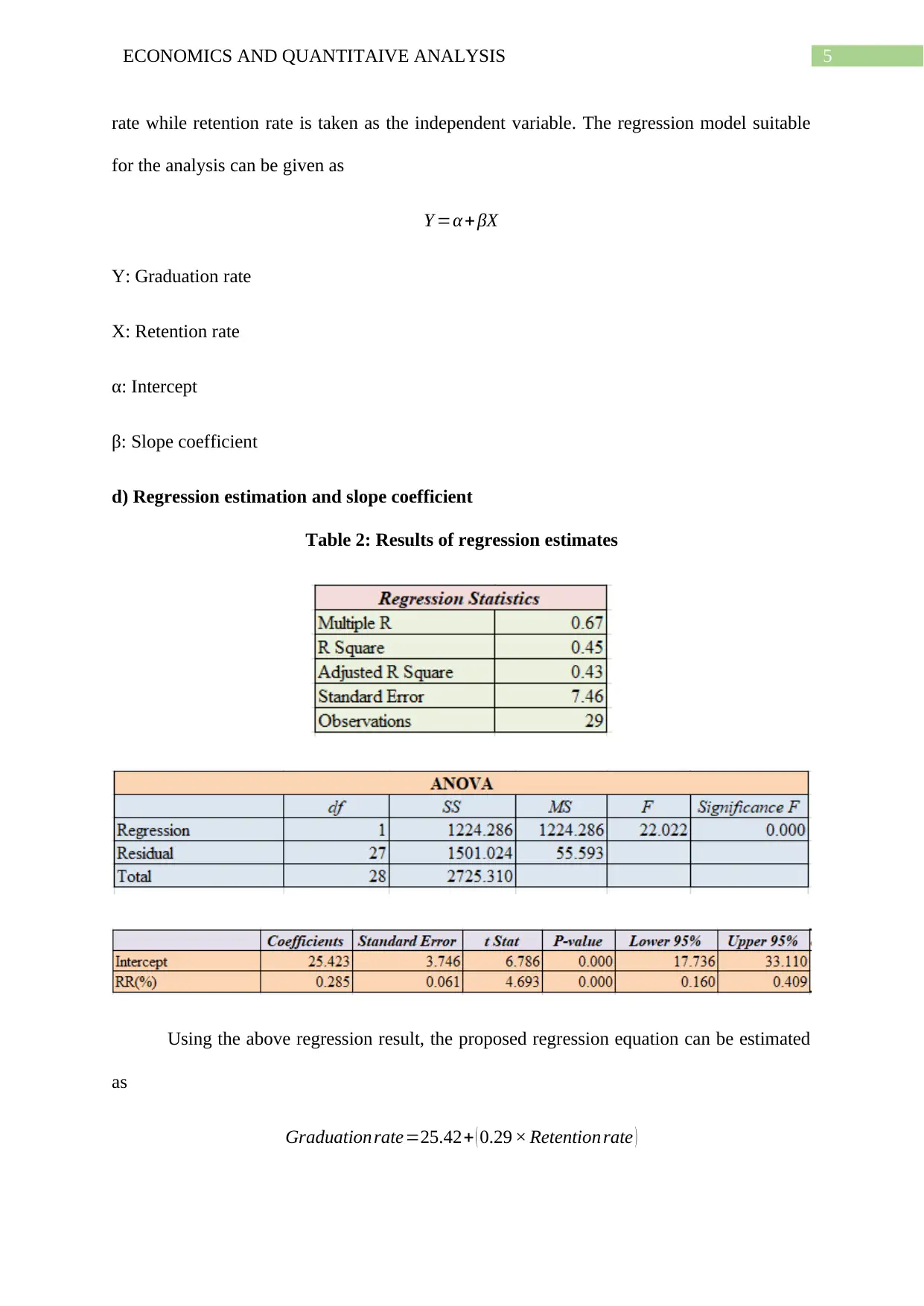
5ECONOMICS AND QUANTITAIVE ANALYSIS
rate while retention rate is taken as the independent variable. The regression model suitable
for the analysis can be given as
Y =α +βX
Y: Graduation rate
X: Retention rate
α: Intercept
β: Slope coefficient
d) Regression estimation and slope coefficient
Table 2: Results of regression estimates
Using the above regression result, the proposed regression equation can be estimated
as
Graduationrate=25.42+ ( 0.29 × Retention rate )
rate while retention rate is taken as the independent variable. The regression model suitable
for the analysis can be given as
Y =α +βX
Y: Graduation rate
X: Retention rate
α: Intercept
β: Slope coefficient
d) Regression estimation and slope coefficient
Table 2: Results of regression estimates
Using the above regression result, the proposed regression equation can be estimated
as
Graduationrate=25.42+ ( 0.29 × Retention rate )
⊘ This is a preview!⊘
Do you want full access?
Subscribe today to unlock all pages.

Trusted by 1+ million students worldwide
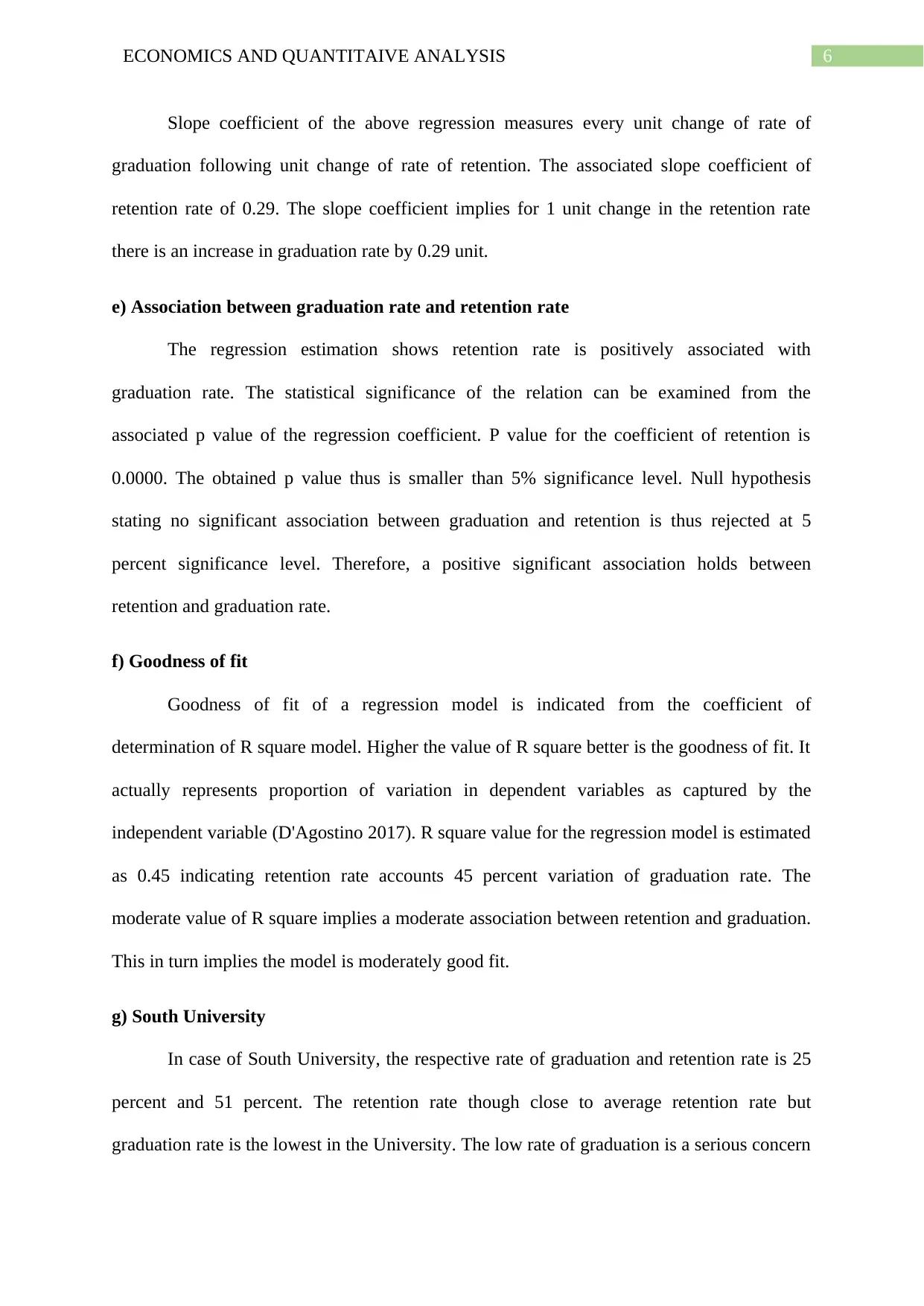
6ECONOMICS AND QUANTITAIVE ANALYSIS
Slope coefficient of the above regression measures every unit change of rate of
graduation following unit change of rate of retention. The associated slope coefficient of
retention rate of 0.29. The slope coefficient implies for 1 unit change in the retention rate
there is an increase in graduation rate by 0.29 unit.
e) Association between graduation rate and retention rate
The regression estimation shows retention rate is positively associated with
graduation rate. The statistical significance of the relation can be examined from the
associated p value of the regression coefficient. P value for the coefficient of retention is
0.0000. The obtained p value thus is smaller than 5% significance level. Null hypothesis
stating no significant association between graduation and retention is thus rejected at 5
percent significance level. Therefore, a positive significant association holds between
retention and graduation rate.
f) Goodness of fit
Goodness of fit of a regression model is indicated from the coefficient of
determination of R square model. Higher the value of R square better is the goodness of fit. It
actually represents proportion of variation in dependent variables as captured by the
independent variable (D'Agostino 2017). R square value for the regression model is estimated
as 0.45 indicating retention rate accounts 45 percent variation of graduation rate. The
moderate value of R square implies a moderate association between retention and graduation.
This in turn implies the model is moderately good fit.
g) South University
In case of South University, the respective rate of graduation and retention rate is 25
percent and 51 percent. The retention rate though close to average retention rate but
graduation rate is the lowest in the University. The low rate of graduation is a serious concern
Slope coefficient of the above regression measures every unit change of rate of
graduation following unit change of rate of retention. The associated slope coefficient of
retention rate of 0.29. The slope coefficient implies for 1 unit change in the retention rate
there is an increase in graduation rate by 0.29 unit.
e) Association between graduation rate and retention rate
The regression estimation shows retention rate is positively associated with
graduation rate. The statistical significance of the relation can be examined from the
associated p value of the regression coefficient. P value for the coefficient of retention is
0.0000. The obtained p value thus is smaller than 5% significance level. Null hypothesis
stating no significant association between graduation and retention is thus rejected at 5
percent significance level. Therefore, a positive significant association holds between
retention and graduation rate.
f) Goodness of fit
Goodness of fit of a regression model is indicated from the coefficient of
determination of R square model. Higher the value of R square better is the goodness of fit. It
actually represents proportion of variation in dependent variables as captured by the
independent variable (D'Agostino 2017). R square value for the regression model is estimated
as 0.45 indicating retention rate accounts 45 percent variation of graduation rate. The
moderate value of R square implies a moderate association between retention and graduation.
This in turn implies the model is moderately good fit.
g) South University
In case of South University, the respective rate of graduation and retention rate is 25
percent and 51 percent. The retention rate though close to average retention rate but
graduation rate is the lowest in the University. The low rate of graduation is a serious concern
Paraphrase This Document
Need a fresh take? Get an instant paraphrase of this document with our AI Paraphraser
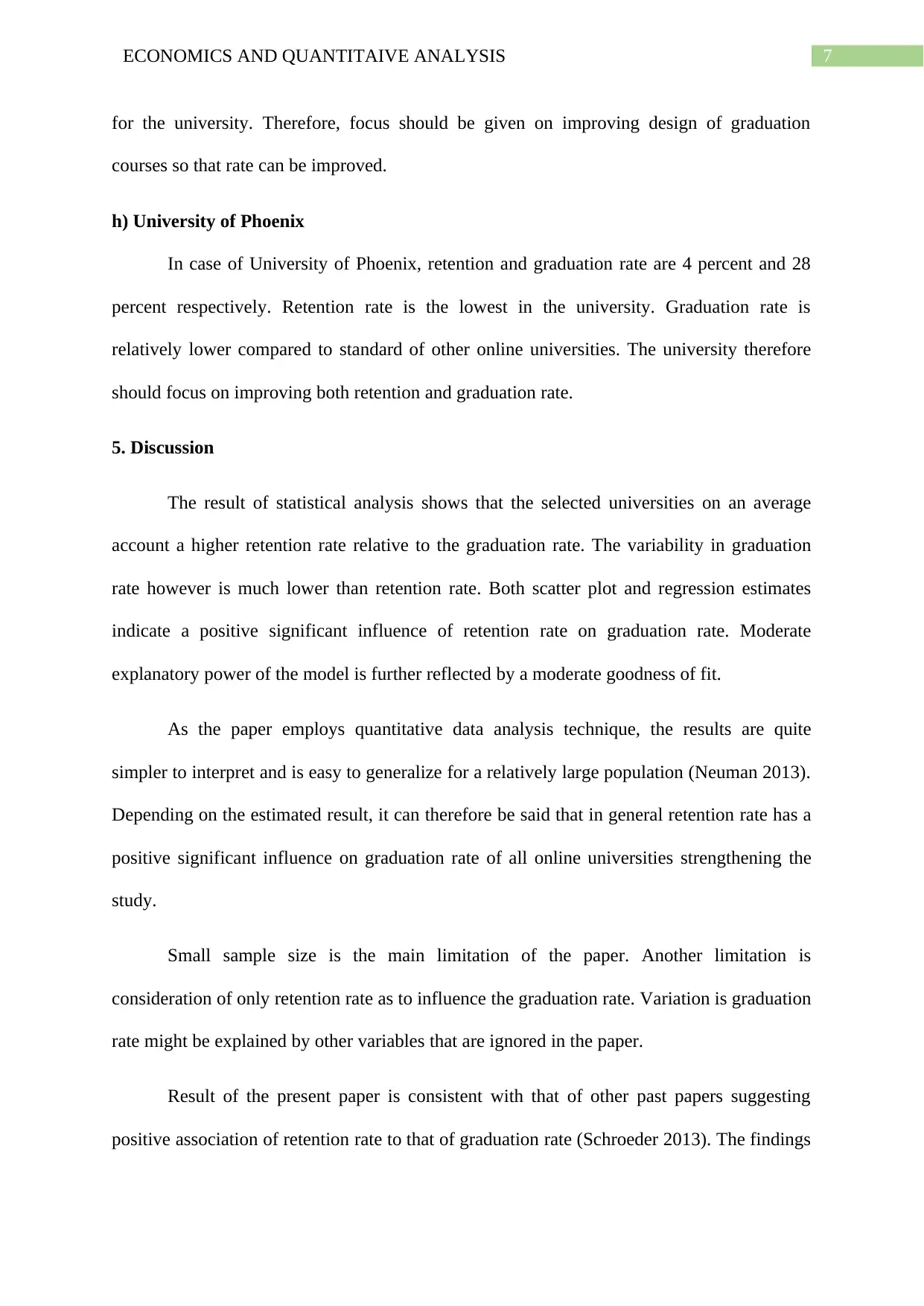
7ECONOMICS AND QUANTITAIVE ANALYSIS
for the university. Therefore, focus should be given on improving design of graduation
courses so that rate can be improved.
h) University of Phoenix
In case of University of Phoenix, retention and graduation rate are 4 percent and 28
percent respectively. Retention rate is the lowest in the university. Graduation rate is
relatively lower compared to standard of other online universities. The university therefore
should focus on improving both retention and graduation rate.
5. Discussion
The result of statistical analysis shows that the selected universities on an average
account a higher retention rate relative to the graduation rate. The variability in graduation
rate however is much lower than retention rate. Both scatter plot and regression estimates
indicate a positive significant influence of retention rate on graduation rate. Moderate
explanatory power of the model is further reflected by a moderate goodness of fit.
As the paper employs quantitative data analysis technique, the results are quite
simpler to interpret and is easy to generalize for a relatively large population (Neuman 2013).
Depending on the estimated result, it can therefore be said that in general retention rate has a
positive significant influence on graduation rate of all online universities strengthening the
study.
Small sample size is the main limitation of the paper. Another limitation is
consideration of only retention rate as to influence the graduation rate. Variation is graduation
rate might be explained by other variables that are ignored in the paper.
Result of the present paper is consistent with that of other past papers suggesting
positive association of retention rate to that of graduation rate (Schroeder 2013). The findings
for the university. Therefore, focus should be given on improving design of graduation
courses so that rate can be improved.
h) University of Phoenix
In case of University of Phoenix, retention and graduation rate are 4 percent and 28
percent respectively. Retention rate is the lowest in the university. Graduation rate is
relatively lower compared to standard of other online universities. The university therefore
should focus on improving both retention and graduation rate.
5. Discussion
The result of statistical analysis shows that the selected universities on an average
account a higher retention rate relative to the graduation rate. The variability in graduation
rate however is much lower than retention rate. Both scatter plot and regression estimates
indicate a positive significant influence of retention rate on graduation rate. Moderate
explanatory power of the model is further reflected by a moderate goodness of fit.
As the paper employs quantitative data analysis technique, the results are quite
simpler to interpret and is easy to generalize for a relatively large population (Neuman 2013).
Depending on the estimated result, it can therefore be said that in general retention rate has a
positive significant influence on graduation rate of all online universities strengthening the
study.
Small sample size is the main limitation of the paper. Another limitation is
consideration of only retention rate as to influence the graduation rate. Variation is graduation
rate might be explained by other variables that are ignored in the paper.
Result of the present paper is consistent with that of other past papers suggesting
positive association of retention rate to that of graduation rate (Schroeder 2013). The findings
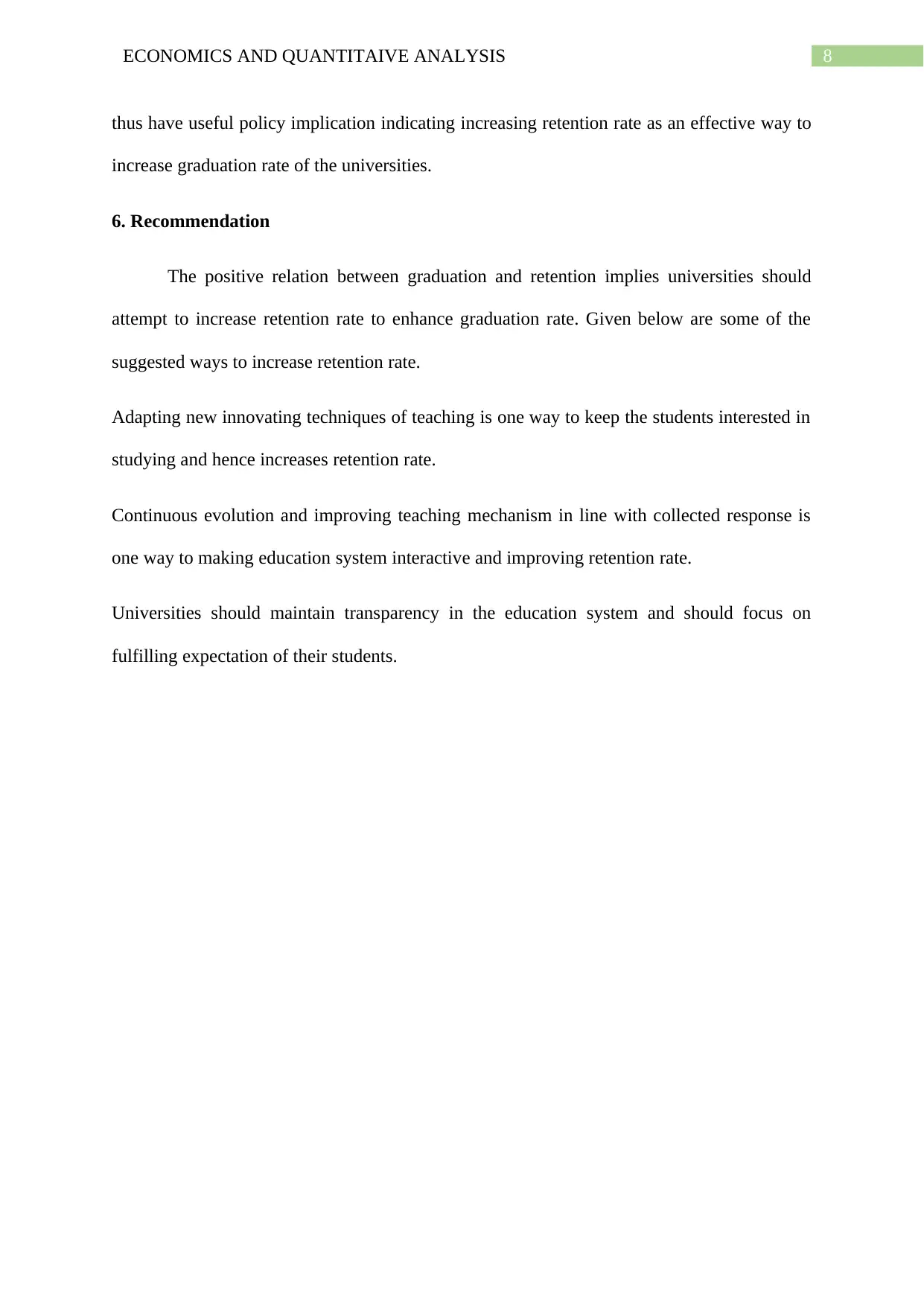
8ECONOMICS AND QUANTITAIVE ANALYSIS
thus have useful policy implication indicating increasing retention rate as an effective way to
increase graduation rate of the universities.
6. Recommendation
The positive relation between graduation and retention implies universities should
attempt to increase retention rate to enhance graduation rate. Given below are some of the
suggested ways to increase retention rate.
Adapting new innovating techniques of teaching is one way to keep the students interested in
studying and hence increases retention rate.
Continuous evolution and improving teaching mechanism in line with collected response is
one way to making education system interactive and improving retention rate.
Universities should maintain transparency in the education system and should focus on
fulfilling expectation of their students.
thus have useful policy implication indicating increasing retention rate as an effective way to
increase graduation rate of the universities.
6. Recommendation
The positive relation between graduation and retention implies universities should
attempt to increase retention rate to enhance graduation rate. Given below are some of the
suggested ways to increase retention rate.
Adapting new innovating techniques of teaching is one way to keep the students interested in
studying and hence increases retention rate.
Continuous evolution and improving teaching mechanism in line with collected response is
one way to making education system interactive and improving retention rate.
Universities should maintain transparency in the education system and should focus on
fulfilling expectation of their students.
⊘ This is a preview!⊘
Do you want full access?
Subscribe today to unlock all pages.

Trusted by 1+ million students worldwide
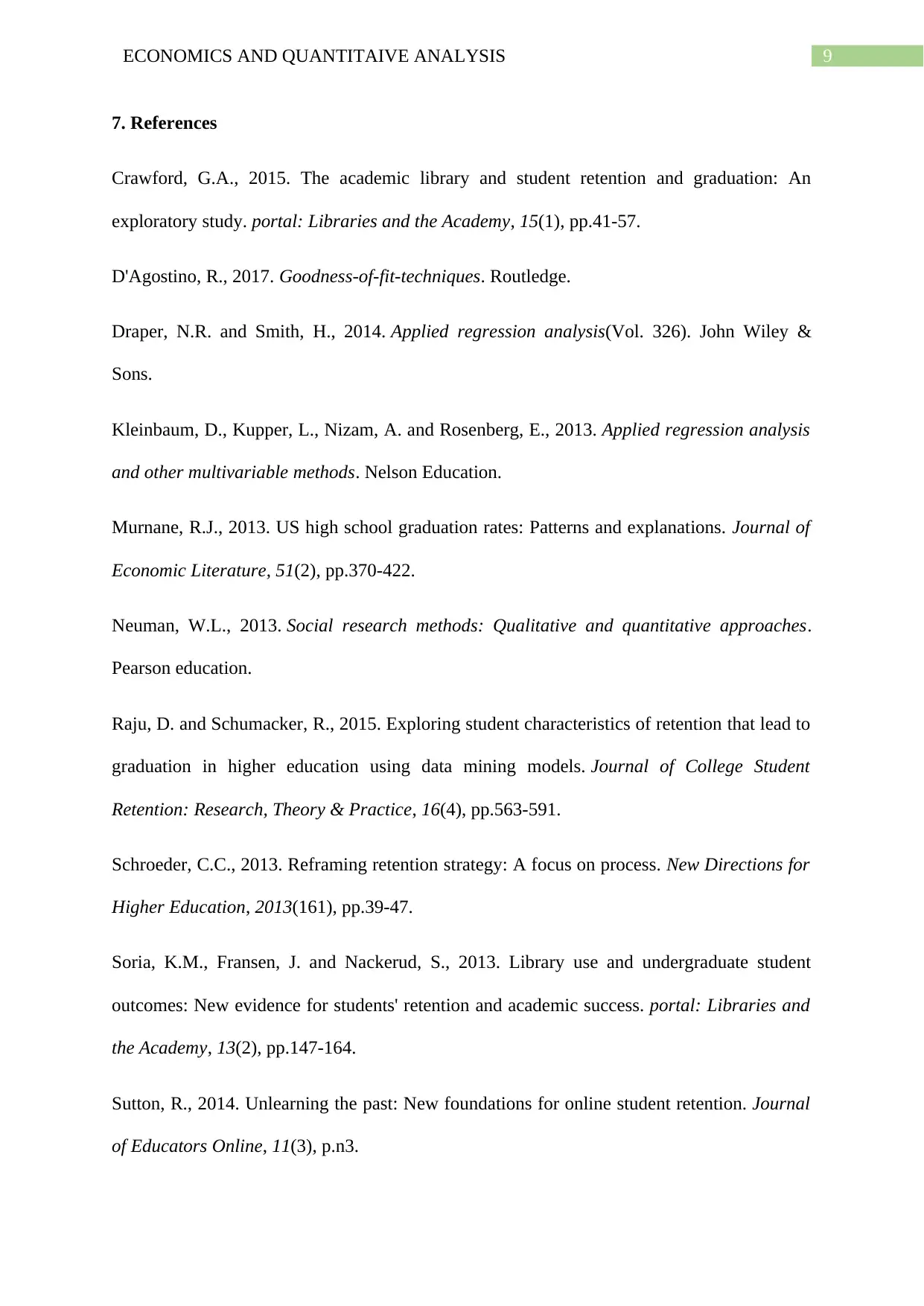
9ECONOMICS AND QUANTITAIVE ANALYSIS
7. References
Crawford, G.A., 2015. The academic library and student retention and graduation: An
exploratory study. portal: Libraries and the Academy, 15(1), pp.41-57.
D'Agostino, R., 2017. Goodness-of-fit-techniques. Routledge.
Draper, N.R. and Smith, H., 2014. Applied regression analysis(Vol. 326). John Wiley &
Sons.
Kleinbaum, D., Kupper, L., Nizam, A. and Rosenberg, E., 2013. Applied regression analysis
and other multivariable methods. Nelson Education.
Murnane, R.J., 2013. US high school graduation rates: Patterns and explanations. Journal of
Economic Literature, 51(2), pp.370-422.
Neuman, W.L., 2013. Social research methods: Qualitative and quantitative approaches.
Pearson education.
Raju, D. and Schumacker, R., 2015. Exploring student characteristics of retention that lead to
graduation in higher education using data mining models. Journal of College Student
Retention: Research, Theory & Practice, 16(4), pp.563-591.
Schroeder, C.C., 2013. Reframing retention strategy: A focus on process. New Directions for
Higher Education, 2013(161), pp.39-47.
Soria, K.M., Fransen, J. and Nackerud, S., 2013. Library use and undergraduate student
outcomes: New evidence for students' retention and academic success. portal: Libraries and
the Academy, 13(2), pp.147-164.
Sutton, R., 2014. Unlearning the past: New foundations for online student retention. Journal
of Educators Online, 11(3), p.n3.
7. References
Crawford, G.A., 2015. The academic library and student retention and graduation: An
exploratory study. portal: Libraries and the Academy, 15(1), pp.41-57.
D'Agostino, R., 2017. Goodness-of-fit-techniques. Routledge.
Draper, N.R. and Smith, H., 2014. Applied regression analysis(Vol. 326). John Wiley &
Sons.
Kleinbaum, D., Kupper, L., Nizam, A. and Rosenberg, E., 2013. Applied regression analysis
and other multivariable methods. Nelson Education.
Murnane, R.J., 2013. US high school graduation rates: Patterns and explanations. Journal of
Economic Literature, 51(2), pp.370-422.
Neuman, W.L., 2013. Social research methods: Qualitative and quantitative approaches.
Pearson education.
Raju, D. and Schumacker, R., 2015. Exploring student characteristics of retention that lead to
graduation in higher education using data mining models. Journal of College Student
Retention: Research, Theory & Practice, 16(4), pp.563-591.
Schroeder, C.C., 2013. Reframing retention strategy: A focus on process. New Directions for
Higher Education, 2013(161), pp.39-47.
Soria, K.M., Fransen, J. and Nackerud, S., 2013. Library use and undergraduate student
outcomes: New evidence for students' retention and academic success. portal: Libraries and
the Academy, 13(2), pp.147-164.
Sutton, R., 2014. Unlearning the past: New foundations for online student retention. Journal
of Educators Online, 11(3), p.n3.
1 out of 10
Related Documents
Your All-in-One AI-Powered Toolkit for Academic Success.
+13062052269
info@desklib.com
Available 24*7 on WhatsApp / Email
![[object Object]](/_next/static/media/star-bottom.7253800d.svg)
Unlock your academic potential
Copyright © 2020–2025 A2Z Services. All Rights Reserved. Developed and managed by ZUCOL.





